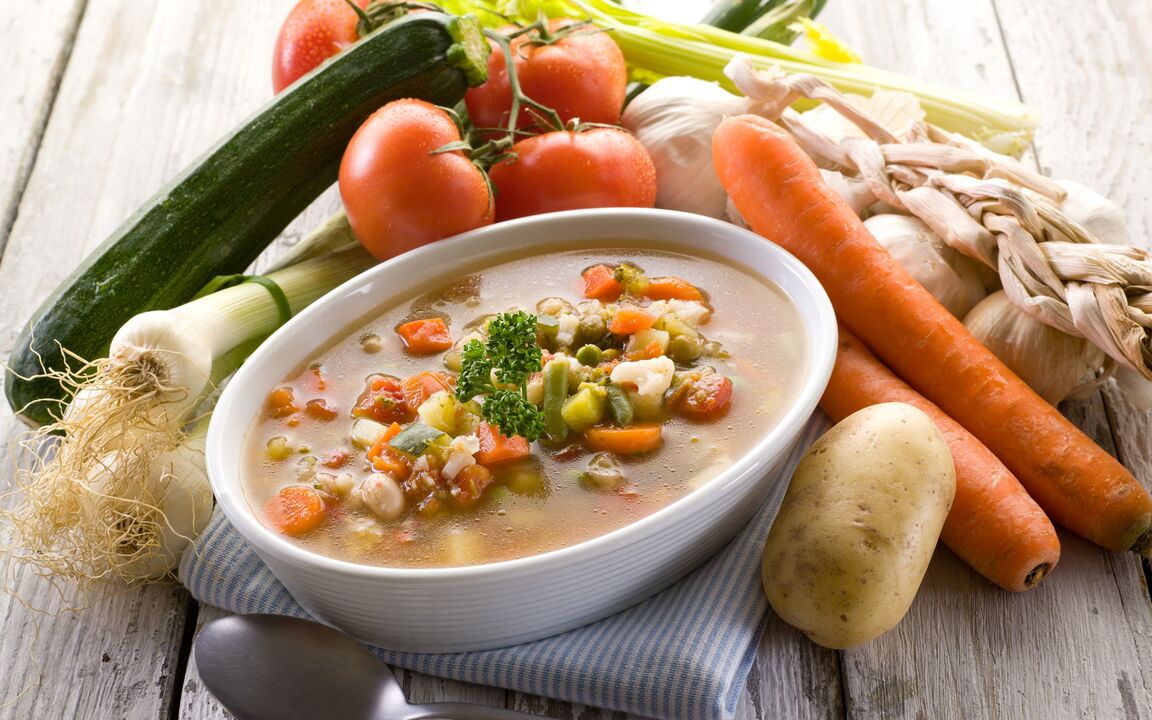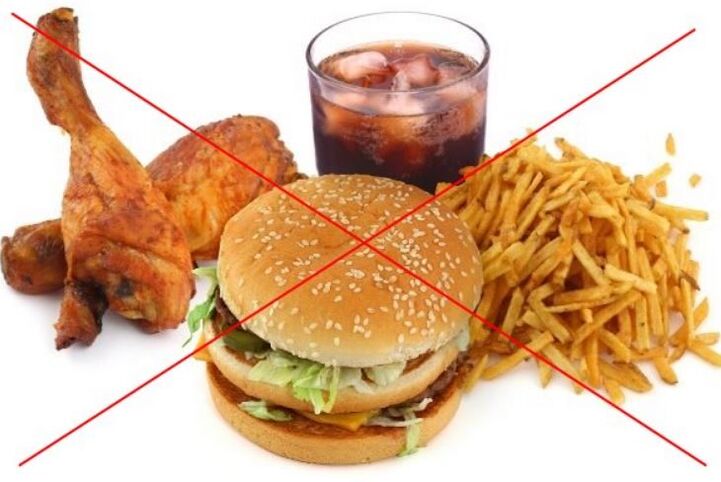Gastritis is one of the most common diseases of our time. Frequent snacks and meals on the run, a variety of fast foods, poor quality food poisoning - all of these can trigger gastritis. Maybe that's why so many people now suffer from stomach diseases. But how to deal with them?
To do this, it is not necessary to constantly take medication, what is important in treatment is a properly and well-chosen diet so as not to irritate the mucous membranes and aggravate the disease, butwhile saturating the body with all the necessary macronutrients and vitamins.

General nutrition rules
- Try to eat 5-6 small meals a day. You should not feel hungry. Let it be 3 full meals: breakfast, lunch and dinner, as well as small snacks.
- The foundation of your diet should be liquid or mashed foods.
- Choose foods that benefit you the most: cereals, soups, fish, meats, eggs, cheeses, milk and dairy products, wholegrain or rye bread, fruits, vegetables and berries.
- Pay attention to the expiration date. Prefer minimally processed natural foods. It's better to choose yogurt with a weekly use-by date rather than a six-month shelf life.
- Eat the number of calories you need, which is easy to calculate using special programs on the Internet.
- Protein (meat and fish, cheese, cheese, milk, eggs), fats (vegetables and butter, cheese, egg yolks, nuts), carbohydrates (cereals, pasta, fruit, dried fruit)dry) should be included in your daily diet.
- Steam, cook in the slow cooker, or bake in the oven. Another cooking option is baking without oil.
Importance!Drink 1-2 liters of purified water per day. This is the main nutritional recommendation not only for people with gastritis but also for healthy people.
List of prohibited products
With this disease, it is contraindicated to eat food that irritates the wall of the stomach. It is also necessary to minimize the consumption of foods that cause excess production of gastric juice. Those products include:
- fried and smoked foods;
- chips and crackers;
- food cooked with a large amount of oil;
- purchased sweets;
- cream;
- flour products;
- lemonade and soda;
- packaged juices;
- purchased mayonnaise, ketchup and sauces;
- wine;
- fast food;
- sour berries and fruit;
- yogurt;
- strong coffee and tea;
- pickled vegetables;
- low-fat dairy products;
- spicy food;
- kvass;
- Canned food;
- meat or fish in its own juice.

While this list may seem pretty impressive, eating healthy and delicious is simple. Remember that many products are interchangeable. For example, instead of unhealthy mayonnaise, you can make a homemade sauce from natural yogurt, eggs, and sunflower oil. Purchased sweets are easy to replace with cheesecake, honey, fruit and dried fruit, unsweetened jam or nuts. So there is always an alternative.
Prohibited food additives
It is important to understand that the same product from different manufacturers can have completely different ingredients. But it depends on the ingredients that you can eat this or that food. So always pay attention to it. Pay special attention to the following components:
- E-104, E-102 - contributes to diseases of the gastrointestinal tract;
- E-122, E-123 - negatively affects digestion;
- E-150, E-151 - interfere with the normal digestion of food;
- E-220 - E-226 - causes stomach upset;
- E-322 - irritation of the stomach wall.
Of course, these are not all additives that negatively affect our health. So try to always choose natural products, without unnecessary preservatives.
List of allowed foods
After reading the list of prohibited foods, you may get the impression that there are hardly many foods. In fact, this is far from the case. You can eat delicious and healthy by focusing on the following foods:
- liquid cereals boiled in water or milk;
- vegetable soup with the addition of cereals;
- puree soup;
- medium or high fat milk or cream;
- scrambled eggs, hard-boiled eggs or soft-boiled eggs;
- pureed vegetables and fruits;
- boiled, grilled or stewed fish or meat;
- honey, marshmallow, marshmallow, natural marmalade;
- a small amount of sugar in tea or coffee;
- vegetables and butter;
- pasta and rice;
- green vegetables;
- fresh vegetables, fruits and berries;
- cottage cheese with a medium percentage of fat content;
- steamed dried fruit;
- jam or jam;
- jelly;
- weak tea or coffee making;
- cheese;
- mineral water that has been previously degassed;
- freshly squeezed juice, diluted with water by half;
- sour cream or homemade sauce.
Diet options for a week with a chronic illness
This menu choice is given as an example in the normal course of the disease, without complications and exacerbations. The amount of food in grams is not written, as it varies from person to person and depends mainly on your gender, age, weight and height as well as your physical activity. Try to eat small meals and not go hungry.
| Breakfast | Snack | Dinner | Snack | Dinner | |
|---|---|---|---|---|---|
| Monday | Rice porridge with milk, whole grain bread and cheese sandwich, green tea | Apple | Grilled cod + pasta | Fresh Cabbage and Carrot Salad | Cheese casserole, tomato and cucumber salad, tea |
| Tuesday | Boiled oatmeal with milk, soft boiled eggs, marshmallows, diluted milk coffee | Banana | Vegetable soup and pureed rice + steamed chicken cutlet | A small portion of almonds | Seasonal vegetable salad + boiled fish |
| Wednesday | Omelette, banana, milk coffee | Syrniki | Pumpkin soup, grilled chicken breast | Pine nuts + natural yogurt | Steamed fish + fresh vegetable salad |
| Thursday | Buckwheat porridge with milk, apple, tea | Curd 5% | Pasta soup, boiled chicken + cucumber and green salad | Kefir | Steamed rice + fish |
| Friday | Omelette, marshmallows, milk coffee | Cheese cake + natural jam | Vegetable broth, grilled fish + buckwheat | Banana | Boiled potatoes + vegetable salad |
| Saturday | Rice porridge, nuts, a spoon of jam, milk coffee | Peaches, nectarines or berries | Macaroni + grilled chicken fillet + cheese | Pastila + tea | Braised cabbage with carrots + steamed fish |
| Sunday | Corn porridge, marshmallows, tea | Apple | Vegetable soup, rye bread, grilled fish | Berry | Omelette + vegetable salad |
Attention!Gastritis also has several different types. And when composing menus, you should not forget them.
Diet of people with gastritis has low acidity
Reduced acidity means that the body's production of hydrochloric acid is difficult. So your diet should support it. Focus on mashed potatoes, liquid cereals, pasta, boiled meat and fish. Make sure to include hard-boiled eggs, vegetable salads, freshly squeezed juices, baked and fresh fruit, slightly stale bread or homemade crackers in your diet. Your diet should be based on a variety of vegetable dishes. It is better to start eating with them. You can add small amounts of spices like cinnamon, turmeric or coriander to your meals.
But fatty meats, legumes, beans, kvass, unripe fruit, carbonated drinks and fresh bread will have to be abandoned.
Diet for gastritis with high acidity
The main goal of such a diet is in direct opposition to the previous one. You need to stimulate hydrochloric acid production in every possible way. To do this, eat plenty of cereals, soups, fresh vegetables, sweet fruits and their products, legumes, beans, zucchini, fresh bread. Refuse spicy and fried foods, spices, seasonings, sour foods and canned vegetables, sour fruits.
What kind of diet to follow with exacerbation of gastritis?
If you suddenly have an exacerbation, then give your stomach a rest. The first day is better not to eat at all, but drink plenty of water. Not only water is perfect for this purpose, but also decoctions of wild rose, chamomile, weak tea with a small amount of sugar.
In the following days, stick to a more strict diet. The foundation of your diet should be cereal and vegetable soups, vegetable puree soups. Add to this liquid porridge boiled with milk and boiled fish or chicken. Ideally, pass all dishes through a meat grinder or blender. You can also eat soft-boiled eggs and cheese casseroles from non-acidic cheeses.
But fruits, vegetables, dairy products, cheeses, cheeses, breads and sweets will have to be dropped during the outbreak.
A diet for gastritis can be not only useful, but also delicious. The main thing is to show more imagination and come up with interesting recipes. In addition, such a diet will positively affect your physique, skin and overall health. And the disease will soon be in remission, because you eat right and balanced.
































